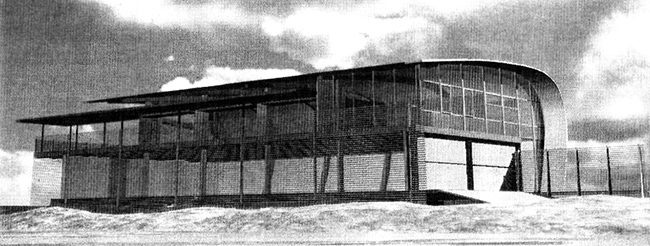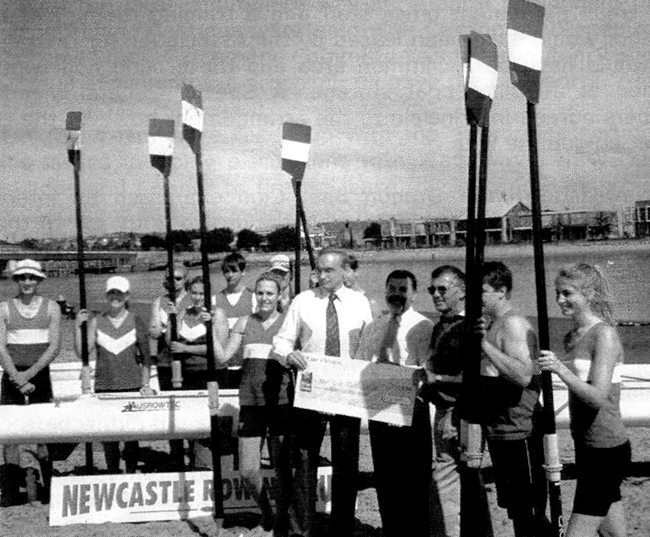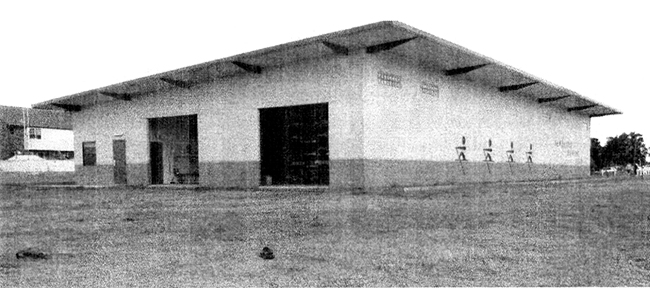History of Newcastle Rowing Club
Part 4 -The Modern Era, 1992 - (continued)
Part 4 pages: 1, 2, 3, 4, 5, 6
Boatshed
Search for a site
The basic requirement of a boat shed is easy access to water. Naturally, a straight stretch two kilometres long and wide enough for a six-lane course would be heaven on a stick. A central location would always be attractive. Given the club's name, it was desirable that the site actually be in Newcastle.

Within this context it was fairly clear from the outset that possibilities available to the club were limited to the harbour foreshore or somewhere along its tributaries, i.e, the Hunter River or the much smaller Throsby Creek. Any vacant land adjoining these waterways is in high demand from competing interests for port facilities, general industry, business, residential development, tourism, recreational use, parkland and retention of natural areas. This aspect was emphasised in 1995 when the (then) NSW Department of Conservation, Planning and Land Management advised the club of its view that the foreshore was over-built and did not encourage its further development. Under these circumstances, a rowing club has to settle for a site that any of the major players either don't want or are not allowed to use. Chances are that if no-one else wants it then it might not be suitable for a rowing club either.
It was in this environment that the club not only had to find a suitable site but also gain the support of the various planning bodies and government instrumentalities. Within the club's first few months, discussions about possible locations were held with various bodies such as the Maritime Services Board, Newcastle Council, Public Works Department, Honeysuckle Development Corporation, real estate agents and private industry. This process continued for many years. (Anyone keeping track will recall that the club had its own boat shed, in the same suburb and just a kilometre away, once before. Then (1880), land had been obtained from the Government and a boat shed built within just four months of the club being established).
Although no possible site could ever be ruled out, attention was focused on three general areas. These were the Wickham/Maryville area or Carrington (on opposite sides of Throsby Creek) or somewhere on the harbour foreshore. As early as 1995, a comment at a committee meeting that "money (an estimated $200,000) will be needed to construct our new shed on Throsby Creek" indentified Carrington as a likely site. Nevertheless, club officials were still obliged to treat every potential site seriously in case it might be the only one on offer. As a result, numerous locations ranging from highly promising to totally unsuitable had to be evaluated over the years.
The following is a list of sites considered throughout the 1990s.
1992
(October) The first formal move to obtain a boat shed. A meeting with the Newcastle Foreshore Redevelopment Group's architects who were preparing a foreshore redevelopment plan for Newcastle City Council. It was agreed that provision would be made in that plan for a rowing club.
1993
(May) Discussions with various government instrumentalities and private organizations regarding existing buildings and available land.
(November) Application to the Honeysuckle Development Corporation (hereafter referred to as the HDC) for a club house site within the Carrington-Throsby precinct.
1994
(March) Between Pat Jordan Oval and Throsby Creek. The NSW Department of Conservation and Land Management declined the request.
(March) One end of refurbished Lee Wharf No 1 building.
(March) Crown land at Carrington.
(April) Lovett, McCracken and Bray premises in the present Marina Precinct.
(April) A section of the Merewether Street Wharf known as the 'South Steyne Wharf ' (named after a former Sydney ferry moored there as a floating restaurant).
(May) Buildings at Carrington basin. Unsuitable, with no room for club storage or facilities.
(August) Lee Wharf No 5 building.
(September) NRC/HDC Steering Committee formed to identify site or building for a new rowing facility.
(September) Woolshed in Hannell Street Wickham used for storage of rarely used boats.
(October) Negotiations with HDC regarding a permanent boat shed site.
Maritime Services Board land at Carrington
(October) In front of (builder) "McCloy's housing development site" at Carrington.
(November) Request to the Maritime Services Board and Newcastle City Council for permission to build on land near Tully and Arnold Street Carrington. This was refused.
(November) Maritime Services Board advises that Newcastle City Council and Department of Conservation and Land Management be consulted about viability of a site near Arnold Street on Throsby Creek.
(November) Land off Arnold Street facing Kennedy Cove raised with HDC. The need for the cove to be dredged to a minimum depth of one metre at low tide may explain the lack of any enthusiasm for the location.
(November) Land on Throsby Creek became available for sale. It was allowed to pass so as not to jeopardise encouraging negotiations with the HDC.
Newcastle Port Authority buildings at either Carrington (opposite the then tug wharf) or one end of a refurbished building on Lee Wharf. At that time, the long-term future of the Lee Wharf sheds was undecided. One of the Lee Wharf sheds re-emerged as a distinct possibility a few years later.
(December) Approaches to NSW Department of Conservation and Land Management and Newcastle City Council regarding land near Arnold Street Carrington.
1995
{February) Carrington between Pat Jordan Oval and high water mark.
(June - July) Perhaps in some desperation, NRC requested HDC to discuss with the Maritime Services Board the possibility of temporary relocation to the western basin adjacent to Forgacs at the eastern end of Dennison Street Carrington. There was a brick amenities block there that would have been suitable for a club house as well as a wharf building nearby for boat storage. Investigation revealed the site was not viable.
(June - August) Lovett, McCracken and Bray premises in the Marina Precinct as a temporary location.
(July - August) Approach to HOC regarding the availability of the "Lee Throsby" site (somewhere east of Maitland) should Forgacs not take up an option.
(July) Ex -Newcastle Port Corporation buildings on No 1 Western Basin.
(July) NSW Department of Conservation and Land Management advises that it does not support any further buildings on the foreshore.
(July) Comfortable in the temporary Urban Transport Authority accommodation, thought grew for a time that it would be easier and cheaper if this shed could be acquired by the club and refurbished as its permanent boat shed. This was never an option as this site was later occupied by the Crown Plaza development
(October - November) Within a proposed new marina.
1996
(January) Refurbished Lee Wharf building No 1 with launching facilities in a new cove proposed to be excavated at the site of the finger wharves where the club pontoon was located. The cove project did not proceed.
(February) In-principle agreement with Newcastle Cruising Yacht Club to share proposed marina if that is the preferred option.
Between Pat Jordan Oval and Throsby Creek. Examined briefly once again.
Presentation to the Board of HDC. Meeting with Lord Mayor and Newcastle City Council.
(June) Marina precinct (again).
Required to vacate Merewether Street Wharf shed. HDC suggested the club locate alternative accommodation. Three general areas were considered suitable. Two were on the Carrington side of Throsby Creek.
1997
(January) HDC raise possibility of shared use of Lee Wharf 'C' Building (westernmost of two similar buildings) in the Civic Precinct.
(January) HDC urge NRC to arrange a boat shed site.
(January) On the Wickham side of Throsby Creek at the SW end of Cowper Street Bridge near a helicopter landing pad operated by a private developer.
Favoured by the club for some time, the land was earmarked for development for residential units as part of the Linwood Estate.
(February) A shed owned by Nova Hydraulics near Carrington Bridge. Not considered ideal but would have been acceptable as a last resort.
(February) Portion of privately owned land at the NE end of the Carrington part of which was used as a helicopter pad.
(March) Club identified three acceptable locations. The preferred was just west of Cowper Street Bridge in Hannell Street. Others were east of Cowper Street Bridge in Hannell Street (next o the Fisherman's CoOp) and on the opposite side of Throsby Creek in Carrington.
(September) Land between the Fisherman's Co-Op and the Cowper Street Bridge came under consideration for a short while. Approaches made to Newcastle Council. Site ruled out by Waterways' intention to use the location to berth harbour ferries. HDC also objected as it obstructed view lines towards the Linwood development.
(September) NRC request use of Lee Wharf 'C' building (a heritage listed cargo sheds in the Civic precinct) to store excess boats.
1998
(January - December) HOC offers the use of part of Lee Wharf 'C' building as a boat shed and clubhouse. Given the disappointing search so far and with that being the only site on offer, plans were drawn up and costings prepared (estimated $776,000 over three stages) in the expectation that that this would indeed be our permanent home. While use of this shed would have meant continued use of the floating pontoon to gain access to the water the biggest drawback was a requirement for a contribution of $25,000 per year towards what was called (believe it or not) a 'sinking fund' to maintain pylons on which the harbour side of the shed rested. HOC suggested a possible joint use with NUBC. Discussions with NUBC and Newcastle University Sports Union regarding sharing the building.
A private developer proposes buildings that house the Water Police and Waterways Authority in Carrington. Not pursued due to poor water access.
(September - October) CivilBuild, owners of a shed at Carrington approached as to whether there was storage that might be available for boats.
(September) Southern end of Arnold Street Carrington investigated (again)
1999
(February) Business Plan required for occupation of Lee Wharf 'C' Building.
(February) Discussions with tenderers regarding the possibility of a rowing club being incorporated into a proposed new marina on Wharf Road. A consultant for one of the tenderers indicated that a floating boat shed would be part of their proposal. It was no surprise to anyone that these ideas came to nothing.
(September) Tender prepared for Newcastle City Council for Lee Wharf 'C' Building.
Adjacent to Fishing Co-op site in Hannell St.
2000
(January - February) HOC assist with search for a site other than the Lee Wharf 'C' building.
(April) Meeting with HOC and inspection of various sites including Lee Wharf 'C' building, west of the Fisherman's Co-operative building, at Carrington opposite the Fishermen's Co-operative building and the State Emergency Services (ex-CIG) complex on the corner of Hannell and Elizabeth Streets Wickham). The latter was regarded as a definite possibility.
Soon afterwards the NSW Maritime Authority identified land at the end of Arnold Street Carrington that could be made available to the club.
This ended that crucial stage in the saga of acquiring a home.
Building Commences
In the euphoria of finally obtaining a site, no one then could have envisaged that it would still take years of work before construction of the building would actually commence. The first issue to emerge (over which the club had no control) was the necessity of the State authorities accurately identifying and consolidating the land to be covered by the lease which was jointly owned by the NSW Maritime Authority and the NSW Department of Lands.
Progress in 2001 was heartening. Early in the year, negotiations were held with the Maritime Authority regarding lease and design issues. Building design was probably less important to the club than it was to the authorities who wanted the building to fit in with new housing developments along the creek. That objective resulted in an architect-designed two-storey building incorporating a curved roof and wall representing an overturned scull (see below). Everyone was excited by the visual similarity between the proposed shed with the Cowper Street Bridge as a backdrop and its Sydney equivalent - the Opera House/ Sydney Harbour Bridge. Waterways and Newcastle Council accepted the design later in the year.

Architects drawing of boatshed as first proposed
A major step was made when the Maritime Authority agreed to issue a lease guaranteeing NRC tenure to use of land. It also granted permission for an application for development approval to be submitted to Newcastle Council. Development consent was granted in November the same year.
Liaison with the local community was an integral component of the club's action plan. Meetings were held with Carrington Branch of the ALP, Throsby Creek Catchment Committee and Carrington Residents Action Group explaining the proposal. All gave their support.
The next few years were taken up with the authorities sorting out land title issues, ongoing discussions with Waterways, NSW Dept of Crown Lands and Council to finalise lease, design and parking issues and presentations to Newcastle Council and Council's Sports Advisory Panel. In 2007, the possibility of a native title claim over the site and creek that had the potential (at the very least) to further delay the project did not eventuate.
Sewage and water mains were extended to the site in August 2007, a prerequisite for a council Construction Certificate. A variation to the development became necessary late in 2007 to allow the building to be relocated within the site.
Early in 2008 the club called for quotes to construct the building. The resultant shock was only relieved by professional trauma counselling and the widespread issue of worry beads. Any concern was justified. Whatever the actual building costs turned out to be they would have been on top of more than $106,000 already spent on essential preliminary works up until July 2008 with nothing visible but a construction fence surrounding a patch of rocks and weeds.
Following consultations with likely builders the building was redesigned with removal of the upper storey: something that could be added sometime in the future. With it went the curved wall and roof. New quotes allowed a contract to be signed with builders, Williams River Steel, in October 2008. Although the changes were such that a new development application was necessary, initial work involving driving 72 wooden piles and laying a concrete pad was carried out in November under the existing development approval.
Sharing
Throughout the process the possibility arose from time to time of sharing a boatshed with other aquatic clubs.
Between 1995 and 1998 discussions were held with NUBC and Newcastle University Sports Union about sharing a boatshed located on the harbour foreshore. Eventually, NUBC decided against the joint proposal and built a boatshed at Berry Park on the Hunter River near Morpeth.
In mid 2006, the club had discussions with the Hunter Surf Life Saving Association with a view to sharing the building. At the time, the Association was seeking suitable long-term office accommodation for a small permanent office staff and a training room. Part of the first floor would have been leased by the Association for the purpose, part would have be a common area and the ground floor would be retained by NRC for boat storage. A Special General meeting of members agreed in principle to the arrangement however the HSLSA did not pursue the idea.
The Newcastle-Hunter Dragon Boat Club expressed an interest in sharing from as early as 2001. Negotiations in 2009 led to the club being granted a long-term lease of a separate section within the new building.
Funding
Even in its basic single-storey configuration the cost of building the boat shed was substantial.
By far the greatest proportion of funding was derived from state and federal government grants. The quest for NSW grants commenced in 1993 concurrent with the search for a building site. Applications were submitted to the NSW Department of Sport and Recreation on a regular basis for a NSW Government Capital Assistance Grant or for assistance under the NSW Regional Sporting Facilities Program. It probably wasn't all that clear at the time but the early applications were bound to fail until the club had obtained formal consent to use a site where grants could actually be applied. Even so, the effort was not wasted. Not only was invaluable experience gained in simply preparing the necessary documentation, regular involvement in the process put the proposal before the Government as a community based project worthy of its support. A sign that progress was being made occurred following the 2003 application which, although unsuccessful, received positive feedback.
Thus it was that persistence, a noble cause and sound argument were rewarded in April 2004 when the NSW Government announced that the Club's latest application for a grant under the Regional Sporting Facilities Scheme had been successful. Shortly afterwards, the NSW Premier Bob Carr formally presented a cheque for $200,000 towards the Newcastle Rowing Club and Aquatic Centre. Celebrations (not funded by the grant) followed at the Brewery.

NSW Premier Bob Carr and the Member for Newcastle Mr Bryce Gaudry MLA present a cheque to club President John McLeod.
An application under the Regional Partnership Scheme was made to the Federal Government in 2007 when storm damage led to the loss of the Throsby Wharf cargo shed that the club was then using for boat storage. That application was successful and a grant of $195,000 was approved the same year.
Those grants were augmented by generous contributions from the HDC and the Newcastle Council which have been long-time supporters as well as from club member, Graham Poole. The Newcastle-Hunter Dragon Boat has negotiated regular payments under a long-term lease agreement.
Naturally, the club was always cognizant that it could not rely on others to fund the project. Accordingly, it raised a large amount over the years specifically for the purpose. In the event of a shortfall, a loan of $100,000 was negotiated with the NAB Bank to cover contingencies.
At Last - Our Own Boatshed
On 20 February 2009 the club was notified that its application for development consent had been approved. Construction work on the previously laid concrete pad commenced in April 2009 and was completed in June. Over the following weeks state-of-the-art boat and oar racks were fabricated and installed by club members allowing boats and other rowing paraphernalia to be gradually transferred to the shed. Rowing commenced in late July on a limited scale to permit grass cover to be established at one end of the shed to provide a suitable boat washing surface.
Attention then turned to the extensive bare area surrounding the shed. The land consists of waste material that had been dumped there as landfill over many decades so a massive landscaping effort that is likely to take months, if not years, has commenced. Work has commenced laying turf in strategic locations, sowing grass seed elsewhere, revegetating with shrubs and trees, weed clearing, and removing a staggering amount of general rubbish and litter. If rocks were worth anything the club's financial future would be secured forever.

NRC's completed boatshed
By late September, with rowing activities re-established and growing the club re-commenced its introductory rowing program. The first regatta to operate from the new shed was in early December 2009 when it was officially opened.
Acknowledgement
Thousands of hours have been spent devoted to the objective of acquiring our own boatshed. Countless meetings, site inspections, reports, plans, budgets, fund raising efforts, applications of one sort of another, pursuit of sponsorships and the like have been a way of life for those closely involved. In the seemingly endless process, cycles of optimism then disappointment became the norm. Many individuals (some of whom will go unrecognised) have contributed to these time-consuming and what must have often seemed like fruitless tasks. However, it is important to appreciate the legacy of those who have been pivotal in achieving this major goal.
Dick Sanders was the principal negotiator and arm twister in the early years until about 1997. The task then passed to a 'Relocation Committee' chaired by Graham Poole. In heading this disparate group Graham brought to the daunting task both business acumen and a network of contacts within the business world. Club member, Alan Slinn, a civil engineer, made an invaluable contribution in time and expertise to optimise design and construction details. It was John McLeod club President since 1999, who bore the brunt of the day-today effort.
SUMMARY
During several eras over the last 130-odd years Newcastle Rowing Club has contributed to the city's proud history of competitive rowing. In that time the club has been present during some of the most exciting and important periods in the sport's development. In its current era, NRC has enrolled more than 700 members. Hundreds of others have learned the fundamentals of rowing and enjoyed a pleasurable experience through the club's introductory training program.
THE FUTURE
Current and former members leave an inspiring history and a fine new shed, a base upon which future generations can build an even stronger and more successful club.
To continue ............. Just Add Water
Part 4 pages: 1, 2, 3, 4, 5, 6
Previous < Twentieth Century Rowing in Newcastle
Next > Appendix A - Boats
